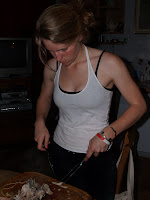A picnic in the lowlands of Scotland
Yesterday we spent the day in the car, travelling with increasing urgency to catch the last ferry to Mull - so that, by the end, Lucius was imitating Lewis Hamilton as we roared along the wonderful road from Crianlarich to Oban, fearful that we may not have left enough time.
On Sunday evening, I made a beef sandwich to eat on the way. I made it with some fillet steak I bought on Saturday morning, and a sandwich loaf. Next time I'll do it with a piece of sirloin and a flatter type of bread - it'll probably be for the picnic on the way down, because this is very good travelling food - and that will make it easier to manage. This will do one family for one picnic, or smaller numbers for a longer journey.
We stopped in South Lanarkshire, near Abington, and found a meadow of wildflowers - huge daisies, ragwort, lots and lots of lovely thistles in flower - where we spread out rugs and cut the sandwich. Cherries for pudding (the boys had fun with a stone-spitting competition). Then we made coffee (I have a little stove and a kettle, which I get out at the drop of a hat, to make proper coffee and decent tea ... later yesterday, our host here on Mull found me on the quayside at Oban, waiting for the ferry and brewing tea ... as a fellow tea drinker, he was very pleased). Then back on the road. Half an hour for a proper meal with delicious food. That wasn't the cause of our need for speed, it was a little misunderstanding between driver and navigator in Glasgow (least said soonest mended).
Travelling beef sandwich
One loaf of bread
one single piece of steak
some flat field mushrooms
a breadknife and a board or plate
The night before your journey starts, cut both the ends off your loaf and hollow it out enough to get the meat in (this is not half as tricky as it sounds, and it doesn't need to be neat or a good fit, because later on you are going to squash the whole thing flat, which will hide all untidiness). Meanwhile, cook the steak in your usual way, making sure that it is as rare as you can bear it. When it is cool enough to handle, push it into the bread, then push in the cooked mushrooms. I found that the best way to get the mushrooms into the middle of the loaf was to use the handle of a spoon.
Wrap in greaseproof paper or foil, and put on a plate and cover with weights to flatten it. Put it in the fridge and either pack or go to bed. If you are like me, write a post-it note reminding you to take the sandwich, otherwise you will have to turn back to fetch it.
Quick and easy, delicious, and, I suspect, infinitely variable - why stop at mushrooms?














































